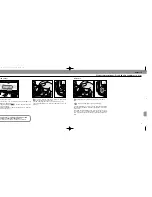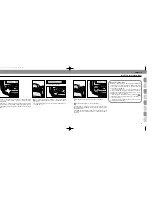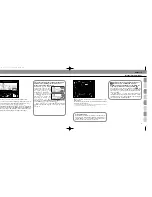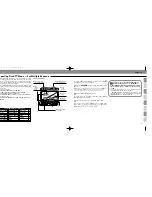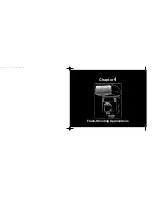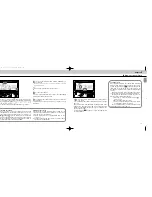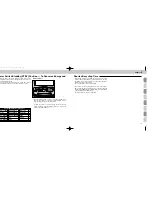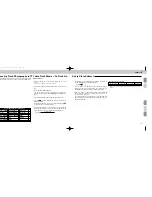
95
94
Chapter
3
Repeating Flash
Mode
9
If necessary, press
or
button to reset the indi-
cator bar
so it points at the measurement scale
that matches or nearly equals the actual flash-to-subject
distance (can be read this from the lens barrel).
Manipulating the indication bar causes aperture value in the
LCD panel to change.
10
Reset aperture value on the camera.
Use an aperture one or two stops smaller than the LCD
panel indicates. This will prevent overexposure for overlap-
ping images (“minus” exposure compensation).*
* Subject will be correctly exposed with the very first flash, but successive over-
lapping images (form the second flash on) will not be properly exposed, unless
you perform minus exposure compensation as indicated in steps 9 and 10. We
recommend you take a few additional shots at different apertures (exposure
bracketing).
Automatic aperture adjustment: F90-Series/
N90, F4-Series, F-801/N8008, or F-801s/
N8008s used with an AF Nikkor lens (including lat-
est D-Type) or Nikkor lens having a built-in CPU
The aperture in use and an indicator bar
are
automatically indicated in the SB-25’s LCD panel. With
other lenses, you must operate manually following
steps 8, 9 and 10.
To skip steps 8, 9 and 10, check whether subject
stands at the location suggested by the LCD’s mea-
surement scale. If not, change the aperture by turning
the lens’ aperture ring to adjust the bar.
Finally, perform “minus” exposure compensation* to
prevent overexposure of overlapping images—use the
aperture ring to choose another aperture one or two
stops smaller than indicated above.
* The aperture indicated by the LCD provides a correct exposure with the
very first flash, whereas overlapped images are illuminated from the
second flash on. It is advisable to take a few additional shots at differ-
ent apertures (exposure bracketing).
8
Set the same aperture value in the SB-25’s LCD Panel
that you set on the camera (step 7).
For instruction, see “Setting Aperture Values (Manual
Adjustment),” pages 28 to 29.
An indicator bar
appears to show appropriate shooting
distance for the selected aperture.
Background brightness and subject overlap
Use as dark a background material as possible (e.g.,
black curtain or cloth). If the overlapping exposed
images are too weak or too strong, try repositioning
subject at the location suggested by the indicator bar
(or adjust indicator bar).
Conditions vary for each situation — try experiment-
ing.
11
Look into camera viewfinder, compose and lightly
press the shutter release button to confirm that sub-
ject is in focus.
Check that ready-light is on in the camera’s viewfinder or
on the SB-25
.
12
Fully depress shutter release button to fire flash.
SB-25_En 03.1.14 8:18 PM Page 94
Содержание SB-25
Страница 1: ...Instruction Manual E Autofocus Speedlight 25_En 03 1 14 8 18 PM Page 1 ...
Страница 4: ...Chapter 1 Introducing the SB 25 Autofocus Speedlight 25_En 03 1 14 8 18 PM Page 6 ...
Страница 10: ...Chapter 2 Before Flash Shooting 25_En 03 1 14 8 18 PM Page 18 ...
Страница 49: ...Chapter 4 Flash Shooting Applications 25_En 03 1 14 8 18 PM Page 96 ...







